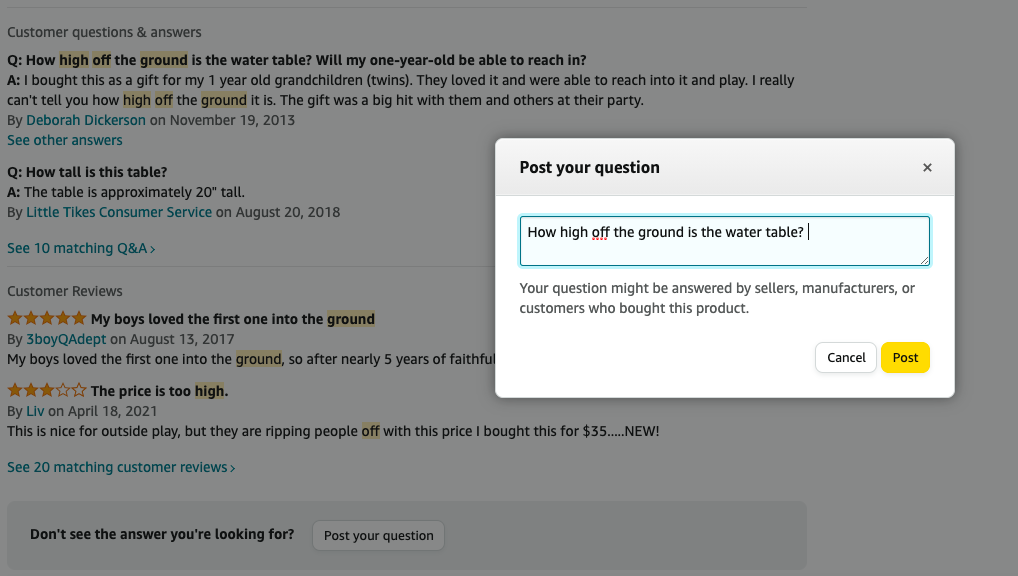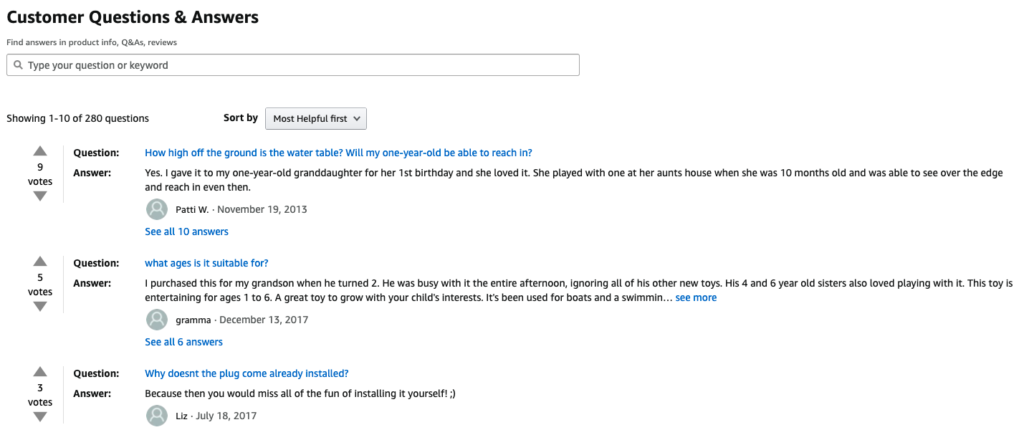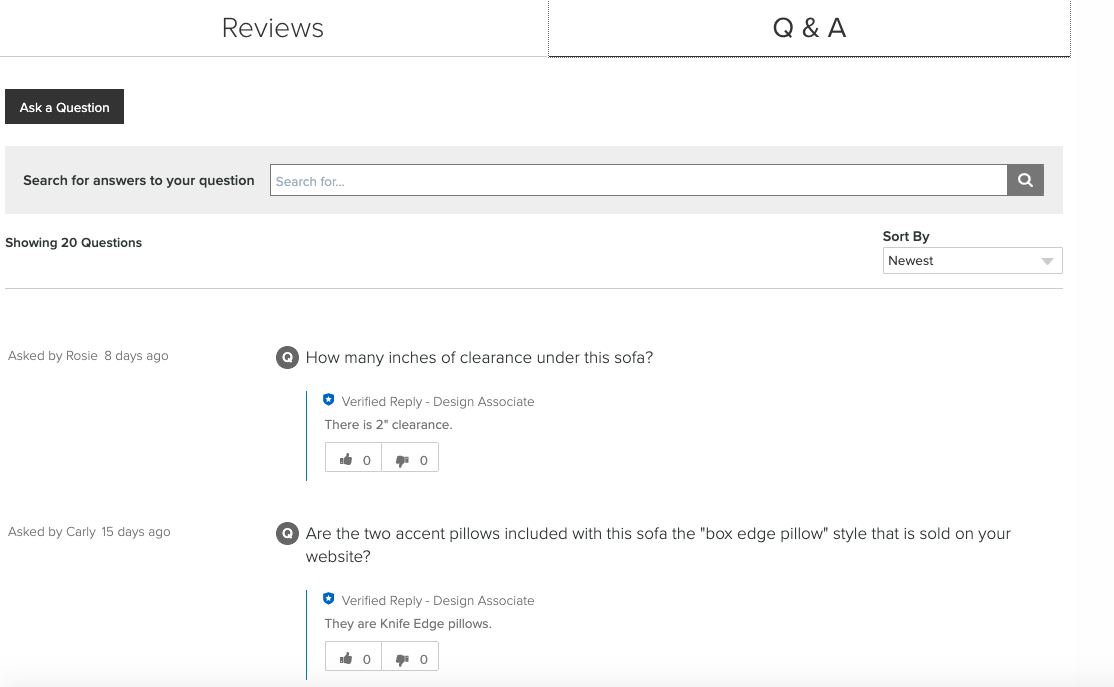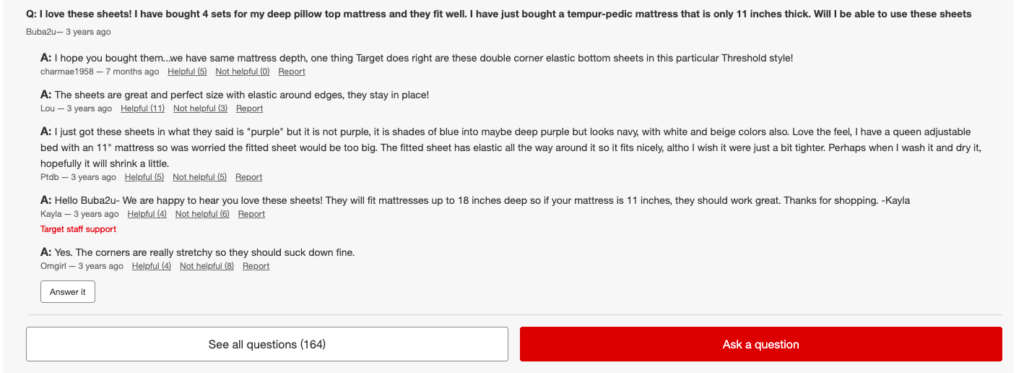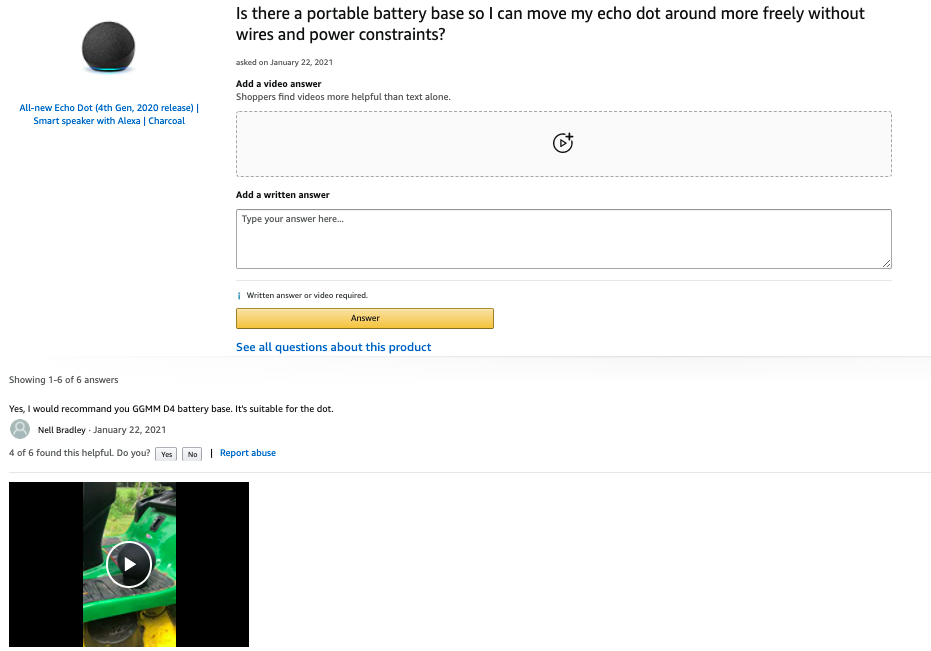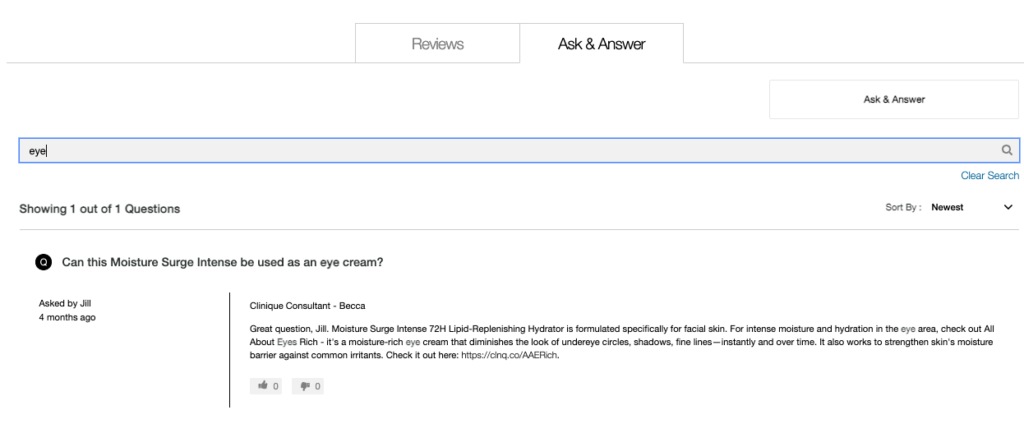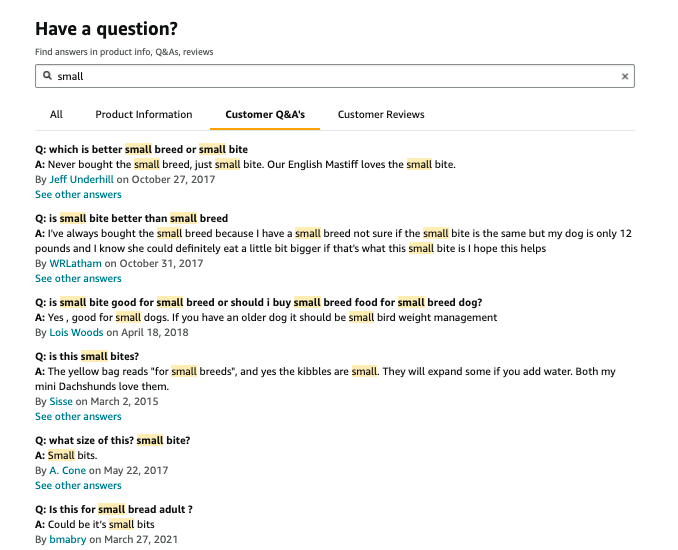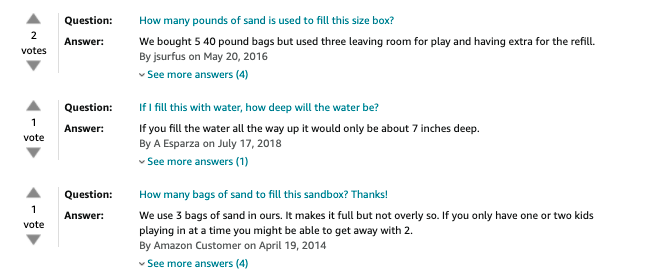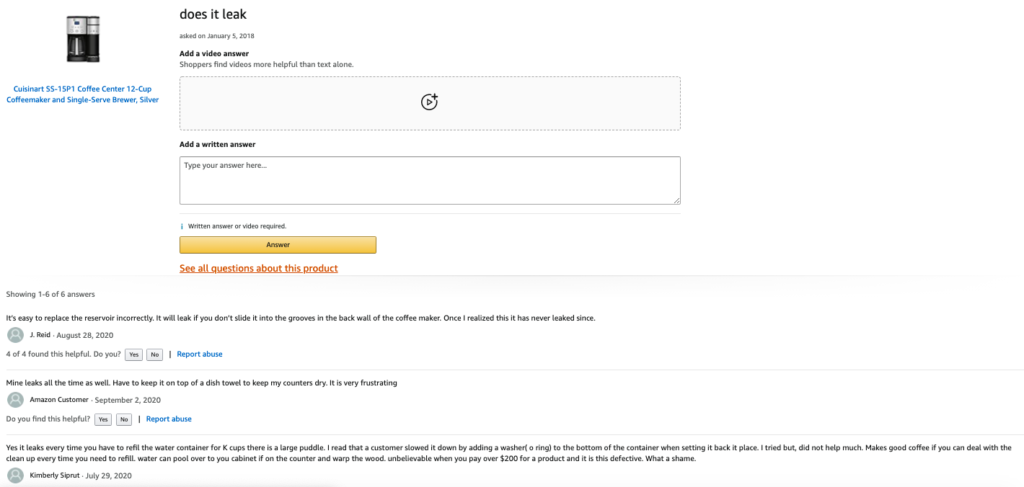6 Things You Might Not Know About Customer Q&As

Imagine there’s a customer shopping for a pair of shoes in a brick-and-mortar store. She’s able to see the shoes in person — and even try them on. And if she has a question standing in the way of her purchase, she can ask the nearest sales associate for help.
Now imagine that same customer is shopping online. She’s read product descriptions and reviews, but she still has a purchase-blocking question. What happens now? According to Forrester, 55% of shoppers will abandon an online purchase if they can’t find a quick answer to a question.
It’s important to provide shoppers with a means to ask their outstanding questions — and get quick answers. And that’s why a growing number of brand and retail sites today incorporate a questions and answers (Q&A) feature onto their product pages.
What is the Q&A Feature?
Q&A has become a common feature on various eCommerce sites and marketplaces such as Amazon, Walmart, Home Depot, Target and Best Buy. Many of the Q&A features you see on the web are powered by the big User Generated Content (UGC) providers: Bazaarvoice, PowerReviews and Yotpo. And then there are local business Q&As on sites like Google My Business and Yelp.
The Q&A feature is a tool shoppers use to ask questions — and get quick answers. On Amazon, a customer can ask their question by clicking on the “post your question” button.
Shoppers might ask questions about the product itself — or they might ask about other things like customer service, shipping or returns. And when they get fast, accurate answers, it boosts their confidence (and the likelihood that they’ll make a purchase).
The question is then displayed on the product page, where it awaits an answer. Amazon Q&A can be answered by sellers, manufacturers or other customers.
But on other websites, including Room & Board, only the brand itself can respond to customer questions.
When consumers get answers to their questions, they’re better able to make informed purchase decisions — and have more realistic expectations.
6 Things You Might Not Know about Q&A
Adding Q&A to your product pages (and then providing fast, accurate answers to questions from your shoppers) is an important way to deliver great shopping experiences. Let’s explore six things you might not know about Q&A.
1. Answers to Shopper Questions can Come in Different Formats
Typically, brands (and other customers, depending on the website) respond to questions submitted via Q&A with written text. For example, here are written responses to a customer’s question on Target.com.
But some eCommerce sites, including Amazon, also allow video responses to questions. For example, this shopper posted in the Amazon Q&A asking whether there’s a portable battery base they can use with their Echo Dot. And another customer responded by posting a video about a battery base they love.
Video is an effective way to convey information to your shoppers. According to Insivia (via Yans Media), consumers retain about 95% of content that’s absorbed from a video, compared to about 10% when read in text. Video responses can be especially helpful when answering questions that are difficult to communicate via text alone. For example, a shopper might post a question asking how loud a vacuum cleaner is. Posting a video of the vacuum in action can be a more effective way to answer this question than typing a response.
2. An Answer to One Shopper’s Question Can Also Help Future Shoppers
Of course, when you answer a customer’s question via Q&A, it helps them make a better, more confident purchase decision. But your answer to one shopper’s question can also empower future shoppers to make better decisions.
How? Many eCommerce sites display a search box that allows shoppers to search through questions that have already been asked by other shoppers. For example, a consumer shopping for moisturizer might wonder if a particular product will work as an eye cream. She does a search through the Q&A for the keyword “eye.” She sees an existing question, with a brand response indicating that there’s a different product that works better as an eye cream. So she decides to purchase that product instead.
Amazon product pages have similar search functionality. However, when a shopper types a word or phrase into the search box, it pulls in results from the product listing, reviews and Q&A. For example, let’s say a consumer is shopping for dog food on Amazon — and they have a question about whether a particular product is good for small dogs. They do a search for “small,” and see results from product information, customer Q&As and product reviews. Then, they can narrow down to see only Q&A that uses the word small. And if they see that their question (or a similar one) has already been asked and answered, it’ll help them understand if the product is a good fit for their needs.
3. Quick Answers to Shoppers’ Questions Can Positively Impact Conversion
As we mentioned earlier, more than half of online shoppers will abandon a purchase if they can’t get a quick answer to a question. On the other hand, if you answer questions quickly, you’ll boost customer confidence — and sell more products. According to our friends at Bazaarvoice, brands and retailers that respond to customer Q&A experience a 98% lift in conversion!
When it comes to responding to Q&A, time is of the essence. Ideally, customers should get answers to their questions while they’re still on the product page. That way, the product will still be top of mind.
Providing answers in real-time can seem impossible — especially if shoppers are submitting questions through multiple sales channels (think Amazon, your own dot com and a network of retailers). But if you use Reputation Studio from 1440, all customer questions from all channels are consolidated into a single platform. That way, you’re better positioned to provide timely answers.
4. Fast, Accurate Answers to Shopper Questions Can Reduce Returns
Some shoppers will decide not to buy a product if they can’t find an answer to their question. But other shoppers will take a risk and purchase the product anyway — especially if the brand has a generous return policy.
But then, if the product arrives and doesn’t meet expectations, the shopper is likely to return it. In fact, CNBC reported that 5-40 percent of online purchases are returned. Returns are a problem, and a costly one at that!
The good news? Providing quick answers to customer questions is a powerful way to keep returns at bay. In fact, according to Bazaarvoice, Q&A can not only reduce return rates, but also result in a 50% decrease in support center costs.
When you answer a question via Q&A, the consumer who posted the question (as well as future shoppers browsing through questions) will have a better idea of what to expect from your products. That means there will be fewer surprises when the item arrives. And the shopper will be less likely to return it.
5. Q&A Positively Impacts Search Results
Search engines prize fresh, relevant content. And Q&A is a great source of fresh, keyword-rich content. So, by generating a steady stream of questions and answers, you can positively impact your search engine ranking. According to our friends at PowerReviews, product pages with answered questions can experience an 88% average increase in traffic, thanks to the SEO benefits of Q&A.
Keyword-rich Q&A can also have a positive impact on how your product pages rank in Amazon search. And the higher the rank, the more eyes on your product pages.
6. Q&A Insights Empower You to Improve Products and Customer Experiences
Customer questions and answers are a rich (but often untapped) source of insights that can help you improve your products — and the experiences your customers have with your brand.
Start analyzing your Q&A content regularly to identify trends that can help you improve your product descriptions. For example, customers frequently ask how much sand this children’s sandbox can hold. This is information the brand should include (or make more prominent) in the product description.
Regularly analyzing your customer Q&A can also give you insight into how your shoppers are talking about your products. For example, you might identify words and phrases to start using on your product pages and in your marketing initiatives.
Finally, if you allow other shoppers to answer customer questions, be sure to analyze these responses, too. It can help you understand what shoppers like (and don’t like) about your products. And these insights can shed light on opportunities to improve your products.
For example, this shopper posted a question on the Amazon product page for a coffee maker, asking if the product leaks. And several customers responded, sharing their frustrations about the leaky machine. This is an issue the brand may not be aware of — and it could be a great opportunity for them to improve the machine.
While it’s true that Q&A content is full of great insights, it can be challenging to uncover. If you’re a Reputation Studio customer, though, you have access to robust analytics that can help you identify trends in your Q&A content — and take meaningful action on the insights you discover.
Start Leveraging Customer Q&A Across Channels to Boost Your Business Results
No matter how comprehensive your product descriptions, online shoppers will still have questions that stand in the way of a purchase. In order to boost customer confidence (and sales), it’s essential to provide fast, accurate answers to these questions.
Ready to see how Reputation Studio makes it easier to more effectively manage your reviews and Q&A — all from a single platform? Contact us to request a live demo.
